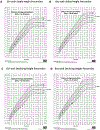Approaches to Identify Factors Associated with Pubertal Timing in Self-Limited Delayed Puberty
- PMID: 36007499
- PMCID: PMC9958281
- DOI: 10.1159/000526590
Approaches to Identify Factors Associated with Pubertal Timing in Self-Limited Delayed Puberty
Abstract
Introduction: Children with self-limited delayed puberty (DP) (constitutional delay) enter puberty after variable waiting times, and the factors associated with their eventual pubertal timing are not well understood.
Methods: We conducted a retrospective study of 99 girls and 228 boys with self-limited DP at an academic medical center between 2000 and 2015. To define features and potential subtypes of self-limited DP, we performed group-based trajectory modeling on childhood growth and latent-variable factor analysis on clinical characteristics. We then conducted time-to-event analyses to identify associations with pubertal timing.
Results: We identified two distinct growth trajectories in individuals with self-limited DP: one with stable and the other with declining height percentiles. Latent-variable factor analysis identified five factors underlying clinical variation that appear to correspond to genetic height potential, body mass index, childhood growth, parental pubertal delay, and medical issues (attention-deficit/hyperactivity disorder and inhaled glucocorticoid use). We observed correlations between pubertal timing and bone age (p = 0.01), childhood height (p = 0.004), and midparental target height (p < 0.001), but not with parental pubertal delay or with testosterone treatment in boys.
Conclusions: By illustrating the heterogeneity within self-limited DP and identifying factors underlying this heterogeneity, our study suggests that there may be multiple causes of self-limited DP. However, our ability to determine when puberty will eventually occur remains limited. Dissecting self-limited DP into its component subtypes may inform future studies of the mechanisms contributing to pubertal delay as well as studies of the short- and long-term outcomes of self-limited DP.
Keywords: Constitutional delay; Growth trajectory; Self-limited delayed puberty; Testosterone treatment.
© 2022 S. Karger AG, Basel.
Conflict of interest statement
Figures



References
-
- Palmert MR, Dunkel L. Clinical practice. Delayed puberty. N Engl J Med. 2012;366(5):443–53. - PubMed
-
- Wei C, Crowne EC. Recent advances in the understanding and management of delayed puberty. Arch Dis Child. 2016;101(5):481–8. - PubMed
-
- Richman RA, Kirsch LR. Testosterone treatment in adolescent boys with constitutional delay in growth and development. N Engl J Med. 1988;319(24):1563–7. - PubMed

